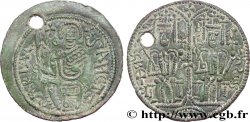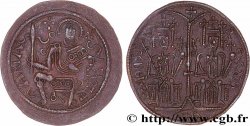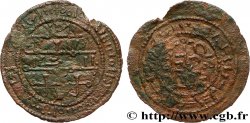Obverse
Obverse legend : INSCRIPTION ARABE CORROMPUE CIRCULAIRE ET AU CENTRE.
Reverse
Reverse legend : INSCRIPTION ARABE CORROMPUE CIRCULAIRE ET AU CENTRE.
Commentary
Historical background
HUNGARY - KINGDOM OF HUNGARY - BELA III
(1173-1196)
In 1161, on the death of King Geza II of Hungary, the Byzantine Emperor Manuel I Comnenus took sides against his son and successor Stephen III and supported with money and arms the "usurper" Stephen IV, brother of the deceased. In the treaty of 1164, Hungary was cut off from several provinces (Croatia, Dalmatia, Bosnia and Sirmia) in favor of the Byzantine. Stephen III's brother, Bela, is recognized as heir to the throne of Hungary and sent to Constantinople where he receives the name of Alexis and the title of despot (which places him immediately below basileus). On the death of Stephen III, Manuel retains his influence by raising the throne of Hungary his protege Bela-Alexis, under the name of Bela III. Bela III first married Anne de Châtillon, then Marguerite, Countess of Vexin and sister of Philippe-Auguste, hence the French influence in his administration. The death of Manuel I (1180) loosened personal ties and three years later, skillfully taking advantage of an alliance with the Serbs and the support of the Pope, Bela III recovered the provinces abandoned in 1164. He died in 1196. Bela III (1148-1196) was King of Hungary from 1172 to 1196. He is the son of Géza II (1141-1161). Ladislas II, brother of Géza II succeeded him in 1162/1163, then the second brother of Géza, Stephen II reigned only two years. Béla's older brother, Stephen III (1165-1172) inherited the throne. Bela III successively married Marie Comnène in 1164, then Agnès de Châtillon in 1168, finally in 1186, Marguerite de France (1158-1198), the daughter of Louis VII.










 Report a mistake
Report a mistake Print the page
Print the page Share my selection
Share my selection Ask a question
Ask a question Consign / sell
Consign / sell
 Full data
Full data









